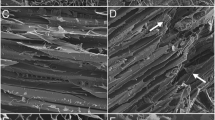Summary
Commercial aniline blue dyes are heterogeneous and variable. We have isolated and purified the fluorochrome from water soluble aniline blue. This fluorochrome fluoresces weakly with a maximum emission around 455 nm but the fluorescence is shifted to longer wavelengths (500–506 nm) when complexed with isolated β-1,3-glucans, cellulose or mixed-linked glucans. A similar intense fluorescence is observed in sieve plates, new cell walls and around pitfields in the presence of the fluorochrome. The fluorescence induced by the aniline blue fluorochrome does not specifically indicate the presence of β-1,3-glucans. Indeed most wall features are induced to fluoresce to some extent by the fluorochrome. However, fluorescence is modified by lignins and phenolics. Furthermore the intense fluorescence induced in the traditional “callose” sites, sieve plates, around pitfields and in new cell walls is probably related to localized differences in the structural packing of wall polymers.
Similar content being viewed by others
References
Anderson, M. A., andB. A. Stone, 1975: A new substrate for investigating the specificity of β-glucan hydrolases. FEBS Letts.52, 202–207.
Arnold, A., 1956: Ein neues Reagenz auf Kallose. Naturwiss.43, 233–234.
Aspinall, G. O., andG. Kessler, 1957: The structure of callose from the grape vine. Chem. and Ind. (London) 1957, 1296.
Barka, T., andP. J. Anderson, 1963: Histochemistry. Theory, practice and bibliography. New York: Harper and Row, Inc.
Currier, H. B., 1957: Callose substance in plant cells. Amer. J. Bot.44, 478–488.
—, andS. Strugger, 1956: Aniline blue and fluorescence microscopy of callose in bulb scales ofAllium cepa L. Protoplasma45, 552–559.
Eschrich, W., 1956: Kallose. (Ein kritischer Sammelbericht.) Protoplasma47, 487–530.
—, andH. B. Currier, 1964: Identification of callose by its diachrome and fluorochrome reactions. Stain Technol.39, 303–307.
Faulkner, G., W. C. Kimmins, andR. G. Brown, 1973: The use of fluorochromes for the identification of β(1→3) glucans. Canad. J. Bot.51, 1503–1504.
Feder, N., andT. P. O'Brien, 1968: Plant microtechnique: some principles and new methods. Amer. J. Bot.55, 123–142.
Fulcher, R. G., M. E. McCully, G. Setterfield, andJ. Sutherland, 1976: β-1,3-Glucans may be associated with cell plate formation during cytokinesis. Canad. J. Bot.54, 539–542.
Heiniger, U., D. P. Delmer, 1977: UDP-Glucose: glucan synthetase in developing cotton fibers. II. Structure of the reaction product. Plant Physiol.59, 719–723.
Herth, W., W. W. Franke, H. Bittiger, A. Kuppel, andG. Keilich, 1974: Alkali-resistant fibrils of β-1,3- and β-1,4-glucans; Structural polysaccharides in the pollen tube wall ofLilium longoflorum. Cytobiol.9, 344–367.
Horobin, R. W., andA. Tomlinson, 1976: The influence of the embedding medium when staining for electron microscopy: the penetration of stains into plastic sections. J. Micros.108, 69–78.
Hughes, J., andM. E. McCully, 1975: The use of an optical brightener in the study of plant structure. Stain Technol.50, 319–329.
Jelsma, J., andD. R. Kreger, 1975: Ultrastructural observations on (1 → 3)-β-D-glucan from fungal cell walls. Carbohyd. Res.43, 200–203.
Karas, I., andM. E. McCully, 1973: Further studies of the histology of lateral root development inZea mays. Protoplasma77, 243–269.
Kraft, W., 1975: The technology of new fluorescence illumination systems. Mikroskopie31, 129–146.
Lillie, R. D., 1969: H. J. Conn's Biological Stains, 8th ed., Baltimore: Williams and Wilkins Co.
McCully, M. E., 1970: The histological localization of the structural polysaccharides of sea weeds. Ann. N. Y. Acad. Sci.175, 702–711.
—, 1966: Histological studies on the genusFucus. 1. Light microscopy of the mature vegetative plant. Protoplasma62, 20–305.
Nakanishi, I., K. Kimura, S. Kusui, andE. Yamazaki, 1974: Complex formation of gelforming bacterial (1 → 3)-β-D-glucans (curdlan-type polysacccharides) with dyes in aqueous solution. Carbohyd. Res.32, 47–52.
Smith, M. M., andM. E. McCully, 1977: Mild temperature “stress” and callose synthesis. Planta136, 65–70.
- - 1978: Methods to enhance aniline blue positivity of cell wall structures. Stain Technol. In press.
Sutherland, J., andM. E. McCully, 1976: A note on the structural changes in the walls of pericycle cells initiating lateral root meristems inZea mays. Canad. J. Bot.54, 2083–2087.
Waterkeyn, L., 1967: Sur l'existence d'un “stade callosique” présenté par la paroi cellulaire, au cours de la cytocinèse. C. R. Acad. Sci. (Paris)265, 1792–1794.
Wilkie, K. C. B., andS-L. Woo, 1976: Non-cellulosic β-D-glucans from bamboo, and interpretative problems in the study of all hemicelluloses. Carbohyd. Res.49, 399–409.
Author information
Authors and Affiliations
Rights and permissions
About this article
Cite this article
Smith, M.M., McCully, M.E. A critical evaluation of the specificity of aniline blue induced fluorescence. Protoplasma 95, 229–254 (1978). https://doi.org/10.1007/BF01294453
Received:
Issue Date:
DOI: https://doi.org/10.1007/BF01294453




